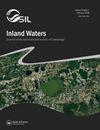湖泊中氧气可用性变化的原因和后果
IF 2.3
3区 环境科学与生态学
Q1 LIMNOLOGY
引用次数: 0
摘要
湖泊和水库中氧气供应的变化是我们这个时代的一个基本湖泊学挑战,对淡水生态系统功能和水质产生巨大影响。跨湖调查、古湖泊学研究和长期监测记录表明,由于气候和土地利用变化,许多湖泊地表和底水的氧气供应都在下降,尽管少数湖泊的氧气供应在增加。通过分析来自~ 400个湖泊的氧气监测数据的时间序列,我发现一些湖泊可能正在经历表面和底部氧气动力学的解耦;在一些湖泊中,表层氧浓度的变异性正在减少,而底部氧浓度的变异性正在增加。氧浓度和变率的变化对湖泊功能有许多影响,因为氧浓度控制着许多生态系统过程。因此,湖泊生态系统供应和文化服务(例如,饮用水、渔业、娱乐)可能会因氧气减少而受损,而氧气变化对调节和支持性生态系统服务(例如,通过反硝化去除硝酸盐、碳掩埋、磷的沉积物通量)的影响可能更加模棱两可。这些挑战激发了一项研究议程,重点是扩大湖泊氧气监测的地理范围、时间持续时间和空间范围,以及研究和管理湖泊的新方法(全生态系统实验、近期氧气预测)。展望未来,传感器技术、监测网络、数据共享和预测的进步,以及环境立法在减少缺氧方面取得的成功,为指导湖泊氧气的恢复和科学提供了重要机遇。本文章由计算机程序翻译,如有差异,请以英文原文为准。
Causes and consequences of changing oxygen availability in lakes
Changing oxygen availability in lakes and reservoirs is a fundamental limnological challenge of our time, with massive consequences for freshwater ecosystem functioning and water quality. Cross-lake surveys, paleolimnological studies, and long-term monitoring records indicate that many lakes are exhibiting declines in both surface- and bottom-water oxygen availability due to climate and land use change, although a few lakes are exhibiting increases in oxygen. By analyzing time series of oxygen monitoring data from ∼400 lakes, I found that some lakes may be experiencing a decoupling of surface and bottom oxygen dynamics; variability in surface oxygen concentrations is decreasing in some lakes while variability in bottom oxygen concentrations is increasing. Changes in both oxygen concentrations and variability have many implications for lake functioning because oxygen concentrations control many ecosystem processes. Consequently, lake ecosystem provisioning and cultural services (e.g., drinking water, fisheries, recreation) will likely be impaired by declining oxygen, whereas the effects of changing oxygen on regulatory and supporting ecosystem services (e.g., nitrate removal through denitrification, carbon burial, sediment fluxes of phosphorus) may be more equivocal. These challenges motivate a research agenda focused on expanding the geographical range, temporal duration, and spatial extent of lake oxygen monitoring, as well as new approaches for studying and managing lakes (whole-ecosystem experiments, near-term oxygen forecasts). Looking ahead, advances in sensor technology, monitoring networks, data sharing, and forecasting, as well as the demonstrated success of environmental legislation in decreasing hypoxia, provide important opportunities for guiding restoration and science on lake oxygen.
求助全文
通过发布文献求助,成功后即可免费获取论文全文。
去求助
来源期刊

Inland Waters
LIMNOLOGY-MARINE & FRESHWATER BIOLOGY
CiteScore
6.10
自引率
9.70%
发文量
34
审稿时长
>12 weeks
期刊介绍:
Inland Waters is the peer-reviewed, scholarly outlet for original papers that advance science within the framework of the International Society of Limnology (SIL). The journal promotes understanding of inland aquatic ecosystems and their management. Subject matter parallels the content of SIL Congresses, and submissions based on presentations are encouraged.
All aspects of physical, chemical, and biological limnology are appropriate, as are papers on applied and regional limnology. The journal also aims to publish articles resulting from plenary lectures presented at SIL Congresses and occasional synthesis articles, as well as issues dedicated to a particular theme, specific water body, or aquatic ecosystem in a geographical area. Publication in the journal is not restricted to SIL members.
 求助内容:
求助内容: 应助结果提醒方式:
应助结果提醒方式:


